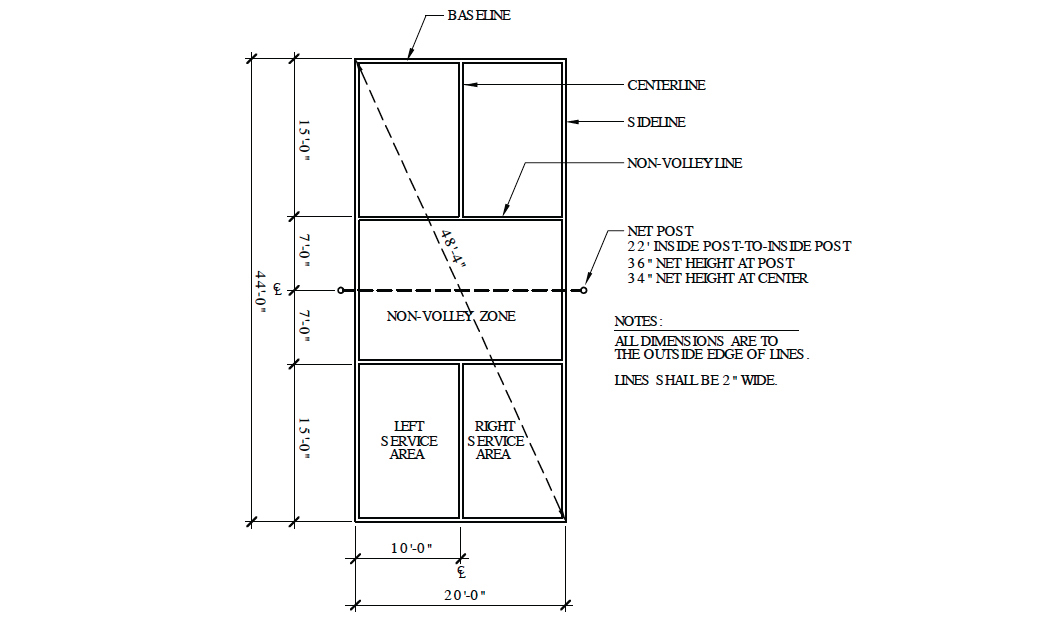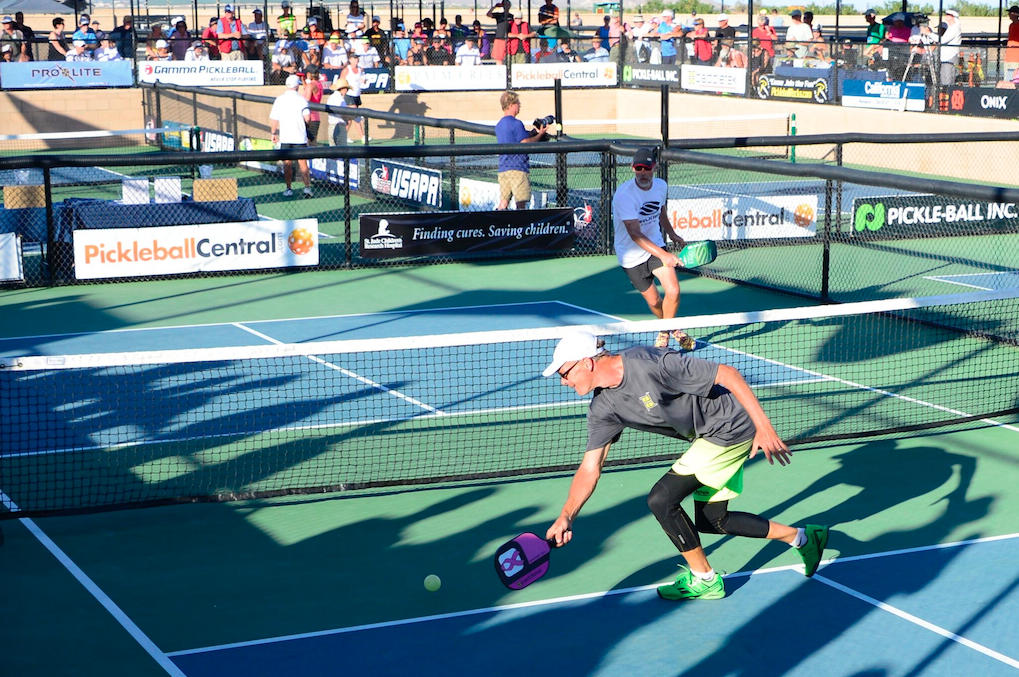Pickleball is the fastest-growing sport among Americans aged 50 or older; younger players are also flocking to it, says the USA Pickleball Association.
Pickleball is played with paddles and a perforated plastic ball, singles or doubles, on a court about one-fourth the size of a tennis court. You can learn the rules and start playing after a half-hour lesson.
If you haven’t included pickleball in your apartment or condominium amenities package, what are you waiting for?
To get the ins and outs of pickleball court design, we consulted Randy Futty, Task Force Leader on the new pickleball construction manual from the American Sports Builders Association (ASBA) and the USAPA (usapa.org), and three Task Force members, all Certified Tennis Court Builders: Colin Donovan, CTCB, Renner Sports Surfaces, Denver; Todd Rudolph, CTCB, Elite Sports Builders, Phoenix; and Linn Lower, CTCB, Lower Bros. Tennis Courts, Birmingham, Ala.
Download the ASBA/USAPA pickleball construction guide. “Pickleball Courts: A Construction & Maintenance Manual” (108 pp., $29.95) is the bible of pickleball design and construction. “If you simply follow the manual, you’re going to get a good pickleball court,” says Futty, Vice President, California Sports Surfaces, Charlottesville, Va.
Hire a qualified installer. The ASBA (sportsbuilders.org) has a directory of member contractors, 62 of whom are Certified Tennis Court Builders. “They’ve been vetted, certified with a test, and make their living building courts,” says Futty.
Involve local players in your planning. Pickleballers are messianic about the sport and will gladly give you valuable free advice on local conditions. Meet with them on the court and try your hand at the game. You’ll be hooked.
Do those three things and you’ll be well on your way to building a first-class pickleball court. Our experts provide further guidance.
Follow the recommended dimensions for pickleball courts. The minimum total surface area is 30x60 feet; the ASBA manual recommends 34x64. If the courts will be used for tournament play, 40x70 is recommended. The net is 36 inches at the sidelines, 34 inches at the center of the court.

Source: Pickleball Courts: A Construction & Maintenance Manual
Don’t cram your courts. Technically speaking, you could squeeze four 30x60-foot pickleball courts into same space as one 60x120-foot tennis court, but they’d be “awful tight,” says Futty. Don’t do it.
Pay careful attention to fencing. The manual recommends 34x64 feet for the fence line. “You don’t want people running into fences, posts, or benches and suing the condo association or apartment management,” says Futty. If possible, add at least a couple of feet around the court, and invest in fence padding, especially if you expect to host younger or more athletic players. “That’s like an insurance policy,” he says.
Rudolph’s advice: “Make sure you have enough gates in your fences so that players don’t have to cross other courts during play.”
Fencing should be a minimum 3½ feet in height, up to 10 feet, says Donovan. “Sometimes we use divider netting to save costs,” he says.
Orient outdoor courts for the sun. “Try for north-south orientation as much as possible, especially if you expect a lot of afternoon play, when the sun is low in the sky,” says Linn.
Comply with local regulations for a sports facility. Check with city hall about zoning, permits, ADA compliance, etc. Get an OK from the local utilities for digging and drilling posts.
Determine your lighting needs. Lighting’s nice to have, and essentially required if the courts are expected to get heavy night use, but it does add to total costs and must be budgeted.
Watch your drainage. “Water is the enemy of any pickleball surface, on the court or coming from below,” says Futty. Follow the grading, slope, and drainage recommendations in the ASBA/USAPA manual.
Provide as many “nice extras” as you can afford. Shaded viewing and rest areas, water fountains, and good pedestrian access and flow are essential, advises Futty.
‘CONDO BUYERS WILL ASK, “DO YOU HAVE PICKLEBALL?” IF NOT, THEY MOVE ON TO THE NEXT SALES OFFICE.’
— Justin Maloof, Executive Director, USA Pickleball Association
Don’t forget the AED (automated external defibrillator). Provide adequate seating, says Rudolph. “Pickleball is a really social sport, and people like to hang out.”
Budget adequately. Futty says pickleball courts can cost anywhere from $20,000 to $40,000, depending on local labor rates, what base you’re using (post-tensioned concrete or asphalt), fencing, lighting, and the type of coating and striping.
Donovan says a single post-tensioned concrete pickleball court in the Denver area runs about $35,000, not including site prep, grading, compaction, etc.
Rudolph says that, in the Phoenix area, a single post-tensioned concrete court on top of finished grade dirt or rock, with fencing, two lights, a set of net posts, and acrylic coatings would come to about $25,000 to $30,000, depending on the lighting choice.
Decide how much “cushion” you want. “Older players need a softer surface,” says Futty. “This allows for proper ball bounce but the player realizes 8-25% force reduction on the body.”
Pickleballs are perforated plastic balls; they don’t bounce like tennis balls. “There are cushioned surfaces that are stiff and good on your knees, but will kill the bounce,” Linn says. “You have to take that into consideration.”
The ASBA manual describes three types of “softer” courts: 1) liquid-applied coatings that contain rubber granules; 2) single-layer “shock pads” applied over the base; and 3) “poured-in-place” systems (primarily for indoor courts).
Rudolph says climate can be a factor for outdoor courts. “If you apply a cushioned layer in Phoenix, the surface temp can hit 140 and the cushion can tear.”
Separate pickleball courts from tennis courts. Tennis players like it quiet, says Rudolph; pickleballers tend to be more sociable—and louder. Rudolph recommends positioning pickleball courts as far from tennis courts as possible. “Windscreen your fences to deaden the sound and help with wind,” he advises.
Pickleball could be the active-recreation centerpiece of your next multifamily project. Your residents will thank you for it.
CONVERT THAT UNUSED TENNIS COURT INTO PICKLEBALL COURTS
If you’re renovating an existing multifamily complex where the tennis courts are not getting used, talk to your client about converting one or more courts to pickleball. “We’re seeing lots of conversions in our area (Arizona, New Mexico, and Texas),” says Todd Rudolph, CTCB, Elite Sports Builders, Phoenix.
The ASBA/USAPA manual on pickleball construction has a section on converting a tennis court to pickleball, which can be as simple as painting or taping new lines. For a full conversion, the ASBA/USAPA construction guide recommends creating only two pickleball courts per tennis court.
“When converting a tennis court to a pickleball court, make sure you know if it is post-tensioned before coring for new sleeves,” says Rudolph. Check your utility lines, too.
The cost for a basic conversion, including fencing (but not lighting or other amenities): about $18,000, says Colin Donovan, CTCB, Renner Sports Surfaces, Denver.
Related Stories
Office Buildings | Jun 28, 2023
When office-to-residential conversion works
The cost and design challenges involved with office-to-residential conversions can be daunting; designers need to devise creative uses to fully utilize the space.
Multifamily Housing | Jun 28, 2023
Sutton Tower, an 80-story multifamily development, completes construction in Manhattan’s Midtown East
In Manhattan’s Midtown East, the construction of Sutton Tower, an 80-story residential building, has been completed. Located in the Sutton Place neighborhood, the tower offers 120 for-sale residences, with the first move-ins scheduled for this summer. The project was designed by Thomas Juul-Hansen and developed by Gamma Real Estate and JVP Management. Lendlease, the general contractor, started construction in 2018.
Affordable Housing | Jun 27, 2023
Racial bias concerns prompt lawmakers to ask HUD to ban biometric surveillance, including facial recognition
Two members of the U.S. House of Representative have asked the Department of Housing and Urban Development to end the use of biometric technology, including facial recognition, for surveillance purposes in public housing.
Apartments | Jun 27, 2023
Average U.S. apartment rent reached all-time high in May, at $1,716
Multifamily rents continued to increase through the first half of 2023, despite challenges for the sector and continuing economic uncertainty. But job growth has remained robust and new households keep forming, creating apartment demand and ongoing rent growth. The average U.S. apartment rent reached an all-time high of $1,716 in May.
Apartments | Jun 27, 2023
Dallas high-rise multifamily tower is first in state to receive WELL Gold certification
HALL Arts Residences, 28-story luxury residential high-rise in the Dallas Arts District, recently became the first high-rise multifamily tower in Texas to receive WELL Gold Certification, a designation issued by the International WELL Building Institute. The HKS-designed condominium tower was designed with numerous wellness details.
Multifamily Housing | Jun 19, 2023
Adaptive reuse: 5 benefits of office-to-residential conversions
FitzGerald completed renovations on Millennium on LaSalle, a 14-story building in the heart of Chicago’s Loop. Originally built in 1902, the former office building now comprises 211 apartment units and marks LaSalle Street’s first complete office-to-residential conversion.
Urban Planning | Jun 15, 2023
Arizona limits housing projects in Phoenix area over groundwater supply concerns
Arizona will no longer grant certifications for new residential developments in Phoenix, it’s largest city, due to concerns over groundwater supply. The announcement indicates that the Phoenix area, currently the nation’s fastest-growing region in terms of population growth, will not be able to sustain its rapid growth because of limited freshwater resources.
Multifamily Housing | Jun 15, 2023
Alliance of Pittsburgh building owners slashes carbon emissions by 45%
The Pittsburgh 2030 District, an alliance of property owners in the Pittsburgh area, says that it has reduced carbon emissions by 44.8% below baseline. Begun in 2012 under the guidance of the Green Building Alliance (GBA), the Pittsburgh 2030 District encompasses more than 86 million sf of space within 556 buildings.
Industry Research | Jun 15, 2023
Exurbs and emerging suburbs having fastest population growth, says Cushman & Wakefield
Recently released county and metro-level population growth data by the U.S. Census Bureau shows that the fastest growing areas are found in exurbs and emerging suburbs.
Engineers | Jun 14, 2023
The high cost of low maintenance
Walter P Moore’s Javier Balma, PhD, PE, SE, and Webb Wright, PE, identify the primary causes of engineering failures, define proactive versus reactive maintenance, recognize the reasons for deferred maintenance, and identify the financial and safety risks related to deferred maintenance.

















